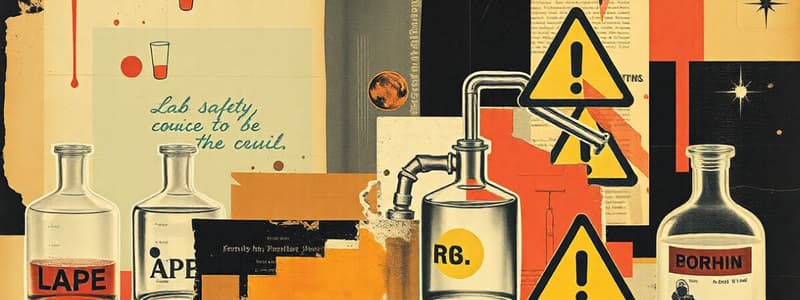Podcast
Questions and Answers
Which action demonstrates a proactive approach to risk management before starting a laboratory experiment?
Which action demonstrates a proactive approach to risk management before starting a laboratory experiment?
- Quickly skimming the experiment to get a general idea.
- Developing a detailed plan outlining goals and steps. (correct)
- Relying on the assumption that all experiments are inherently safe.
- Immediately beginning the experiment to save time.
What is the primary reason for avoiding rushing during laboratory work?
What is the primary reason for avoiding rushing during laboratory work?
- To adhere to standardized timings for experiments.
- To ensure all team members can keep up with the pace.
- To minimize the likelihood of errors and potential hazards. (correct)
- To conserve materials and resources.
Why is a comprehensive understanding of the experiment, especially the risks involved, vital before beginning?
Why is a comprehensive understanding of the experiment, especially the risks involved, vital before beginning?
- To impress colleagues with preparedness.
- To streamline the experimental process and save time.
- To anticipate potential hazards and implement appropriate safety measures. (correct)
- To ensure the experiment yields the desired results.
Which of the following practices is crucial for identifying potential hazards associated with chemicals in the laboratory?
Which of the following practices is crucial for identifying potential hazards associated with chemicals in the laboratory?
Why is wearing personal protective equipment (PPE) essential before entering the laboratory?
Why is wearing personal protective equipment (PPE) essential before entering the laboratory?
What is the primary justification for the prohibition of eating or drinking in the laboratory?
What is the primary justification for the prohibition of eating or drinking in the laboratory?
How does keeping flames away from work contribute to laboratory safety?
How does keeping flames away from work contribute to laboratory safety?
What is the importance of ensuring the correct tubes are used for an experiment?
What is the importance of ensuring the correct tubes are used for an experiment?
Why is working alone or outside of standard hours discouraged in a laboratory setting?
Why is working alone or outside of standard hours discouraged in a laboratory setting?
In the event of a chemical splash to the skin, what is the most appropriate immediate action?
In the event of a chemical splash to the skin, what is the most appropriate immediate action?
What should a lab worker do if they notice a strange smell in the lab?
What should a lab worker do if they notice a strange smell in the lab?
Which of the following actions would be considered unsafe in a chemical laboratory environment?
Which of the following actions would be considered unsafe in a chemical laboratory environment?
If a fire starts, what immediate action should a lab worker take after activating the fire alarm?
If a fire starts, what immediate action should a lab worker take after activating the fire alarm?
What is the purpose of using a fume hood during experiments that produce hazardous vapors?
What is the purpose of using a fume hood during experiments that produce hazardous vapors?
How should broken glassware be handled in the laboratory?
How should broken glassware be handled in the laboratory?
Why should lab workers avoid wearing loose clothing or dangling jewelry in the lab?
Why should lab workers avoid wearing loose clothing or dangling jewelry in the lab?
If a lab worker accidentally spills a chemical, what should be their first course of action?
If a lab worker accidentally spills a chemical, what should be their first course of action?
What is the purpose of a safety data sheet (SDS)?
What is the purpose of a safety data sheet (SDS)?
Why is it important to properly label all chemical containers in the laboratory?
Why is it important to properly label all chemical containers in the laboratory?
What should you consider when choosing gloves for a task?
What should you consider when choosing gloves for a task?
Flashcards
Lab Safety Definition
Lab Safety Definition
A set of procedures and rules to protect laboratory workers from injury, property from damage, and provide safe environments.
Main Lab Hazards
Main Lab Hazards
Fires, toxic chemicals (skin/eye exposure), gas leaks, glass exposure, electric shock, and hot objects.
Risk Management Rules
Risk Management Rules
Having a plan, avoiding rushing, reading experiment instructions, checking chemical names, and wearing PPE.
Personal Protective Equipment (PPE)
Personal Protective Equipment (PPE)
Signup and view all the flashcards
No Eating or Drinking
No Eating or Drinking
Signup and view all the flashcards
Always Use Lab Coat
Always Use Lab Coat
Signup and view all the flashcards
Always Use Gloves
Always Use Gloves
Signup and view all the flashcards
Handle Instruments With Care
Handle Instruments With Care
Signup and view all the flashcards
Wash Hands After Lab
Wash Hands After Lab
Signup and view all the flashcards
No Litter
No Litter
Signup and view all the flashcards
Study Notes
- Safety in laboratories is defined as a set of procedures and rules designed to protect laboratory workers from injury, property from damage and loss, and to ensure safe working environments.
Main Hazards in Chemical Laboratories
- Fires can occur due to preparations or practical experiments.
- Skin and eye areas are susceptible to burns and exposure to toxic chemicals.
- Leakage of toxic or irritant gases is a hazard.
- Exposure to residues or glass fragments can occur.
- Contact with electric current poses a risk.
- Contact with hot objects can cause burns.
General Rules for Risk Management in Laboratories
- Develop a plan of action prior to entering the lab, outlining goals and procedures.
- Avoid rushing, as it can lead to harmful mistakes.
- Carefully read the experiment instructions, with attention to potential risks, before starting.
- Verify what chemicals do, read the chemical names, and read the labels on bottles or special containers.
- Personal protective equipment (lab coat, face mask, gloves, protective glasses) must be worn before entering the laboratory.
- Eating and drinking are prohibited in the laboratory.
- Keep flames away from experiments as much as possible.
- Use the appropriate tubes for the experiment being conducted.
- Avoid working alone and outside of scheduled hours.
Biology Lab Safety Rules
- Lab coats and gloves should always be worn.
- Handle instruments with care.
- Wash hands after lab.
- No food or drinks are allowed.
- No littering.
General Signs
- Radioactive
- Biohazard
- Harmful
- Explosive
- Corrosive
- Dangerous for the environment
- Flammable
- Toxic
- Oxidizing
Studying That Suits You
Use AI to generate personalized quizzes and flashcards to suit your learning preferences.




